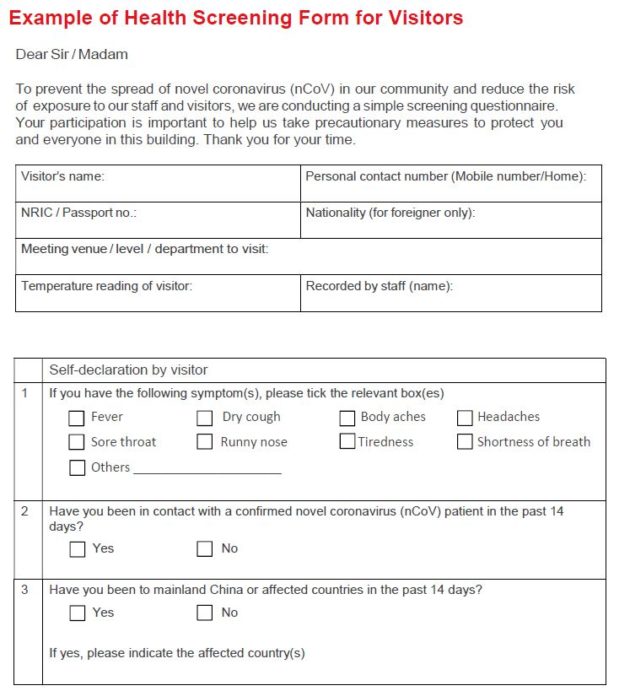Enterprise Singapore has released a PDF guide on business continuity planning (BCP) for employers, and HR & operational leaders to deal with the 2019-nCoV outbreak in Asia. It is guided by the Singapore Standard for Business Continuity Management System – requirements, and relevant advisories.
The guide covers the following key business operational risks, summed up below:
- Human resource management
- Processes and business functions
- Supplier and customer management
- Communications, both internal and external
[Download the full guide here]
Human resource management
a. A flu manager should be appointed to ensure that employees are familiar with the business continuity plans and comply with them during this period. Their responsibilities include collating updated contact information of all employees, i.e. home address/home telephone number, and actively disseminating messages to employees with clear instructions when measures need to be activated.
b. Develop a plan for the continuity of leadership in the event of absence of key decision makers and executives.
c. Consider flexible work arrangements (FWAs) for the high-risk employees, as well as employees who need to stay at home due to other reasons relating to the novel coronavirus (nCoV), e.g. to take care of family members who have travelled to known affected countries or regions.
d. Review employee management policies such as absenteeism, sick leave, overseas travel, workplace closure and recall of non-critical employeees and their families from affected countries.
e. Defer all travel to Hubei Province and all non-essential business travel to Mainland China.
f. Obtain a health and travel declaration from employees who have travelled to China recently, or who have any upcoming plans to travel to China.
g. Check and monitor closely the health condition of employees who had been in China in the past 14 days. Employees who have been issued with a Leave of Absence should monitor their health closely for 14 days upon entering Singapore. During the 14-day monitoring period upon their return, FWAs, such as telecommuting and teleconferencing, can be considered for employees to work from home.
h. Exercise readiness to implement public health response measures, e.g. contact tracing and social distancing, as advised by the MOH.
i. Review health insurance policies for workers.
Process and business functions
a. Identify critical business functions (prioritised activities) and essential employees. Enterprises should consider the following:
- Set up alternate teams of employees (e.g. Team A & Team B) who can be deployed at different work schedules (e.g. Team A working in the office at alternate weeks, while Team B telecommutes).
- Team A and Team B should be physically segregated to avoid the risk of infection between teams.
- Cross-train workers and establish covering arrangements to minimise disruptions.
b. Educate employees on infection control and good personal hygiene.
c. Develop plans related to visitor and employee screening and follow-up actions, such as health screening form, making temperature checks mandatory, or arranging other means of communication.
Example of health screening form for visitors:
d. Monitor closely the novel coronavirus (nCoV)-related developments and follow travel and health advisories on the MOH and other government agencies’ websites.
e. Develop a robust employee sickness surveillance process to identify and manage unwell employees.
f. Ensure adequate supply of appropriate Personal Protection Equipment (PPE) and medical equipment (e.g. thermometers, disposable gloves, surgical masks, N-95 masks and disinfectants) and undertake training to familiarise employees on their usage.
g. Clean and disinfect companies’ premises exposed to suspected or confirmed case(s) of the novel coronavirus (nCoV).
Supplier and customer management
a. Identify essential suppliers and service providers, and discuss continuity issues with them such as understanding and implementation of their BCP.
b. Identify essential customers and ensure that plans are in place to meet customer needs.
c. Develop a plan on how and when to activate:
- Alternative suppliers
- Alternative delivery means to customers.
Communications
a. Begin by identifying a communications coordinator who will disseminate your communications plan in line with your business needs and business continuity plans
b. Ensure that employees have a clear understanding of their roles and responsibilities before the virus outbreak occurs. For example, employees should be informed of the BCP measures that will impact them. Consider setting up a communication channel for employees to report their status and to make enquiries.
c. Identify the relevant stakeholders such as suppliers, service providers and customers, and key messages for each stakeholder group; and begin a dialogue with them on potential contingency measures during a virus outbreak.










